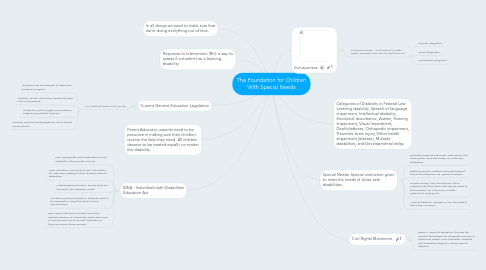The Foundation for Children With Special Needs
by Jenny Cowley


1. IDEA - Individuals with Disabilities Education Act
1.1. Free Appropriate Public Education (FAPE): entitled to attend public schools
1.2. Least restrictive environment (LRE): educated in the education setting of other students without disabilities.
1.3. Individualized education: services that are tailored to the students' needs.
1.4. Nondiscriminatory evaluation: students need to be assessed in a way that doesn't show discrimination.
1.5. Zero reject/child find: a student cannot be rejected because of a disability. States also need to actively seek out those with disabilities to they can receive those services.
2. Parent Advocacy: parents need to be proactive in making sure their children receive the help they need. All children deserve to be treated equally no matter the disability.
3. Current General Education Legislation
3.1. No Child Left Behind Act (NCLB)
3.1.1. Students must be assessed to determine academic progress
3.1.2. Student's scores need to be reported to help inform the parents.
3.1.3. Students must be taught core academic subjects by qualified teachers.
3.1.4. Teaching practices and programs must be based off of research.
4. Response to Intervention (RtI): a way to assess if a student has a learning disability.
5. In all things we need to make sure that we're doing everything out of love.
6. Special Needs: Special instruction given to meet the needs of those with disabilities.
6.1. Specially designed instruction: instructions that is tailored to meet the needs of a child with disabilities.
6.2. Related Services: Additional services beyond that of the classroom. Ex. Speech therapist
6.3. Supplementary AIDS and services: other supports that allow those with special needs to be successful. Ex. more time on tests, preferential seating, etc.
6.4. Accommodations: changes in how the student learns key curriculum.
7. Civil Rights Movement
7.1. Brown v. Board of Education: this was the decision that began the integration process of blacks and whites. Soon thereafter, students with disabilities began to receive special attention.
8. Inclusiveness
8.1. Inclusive Practices - In all areas of a child's needs, we need to be sure to meet them all.
8.1.1. Physical Integration
8.1.2. Social integration
8.1.3. Instructional integration
